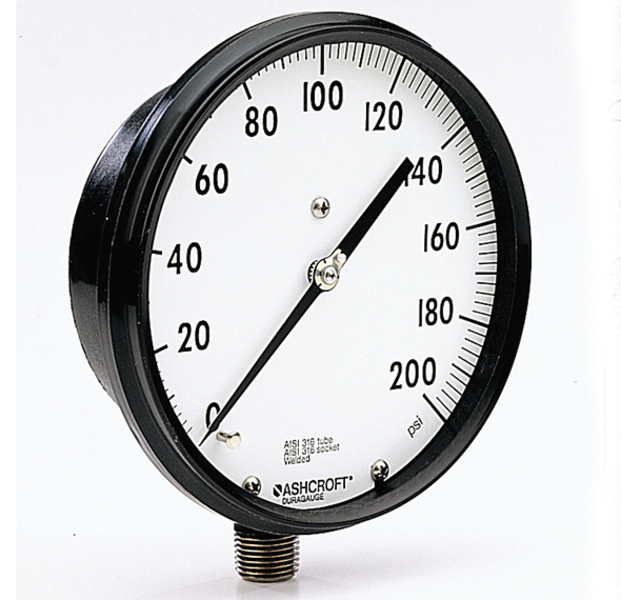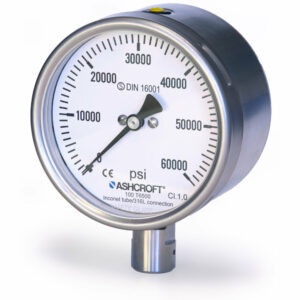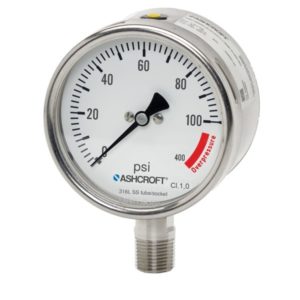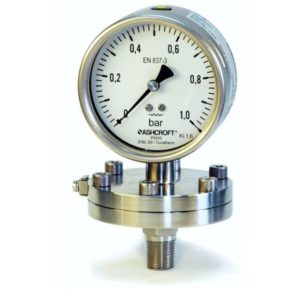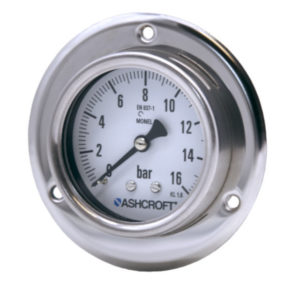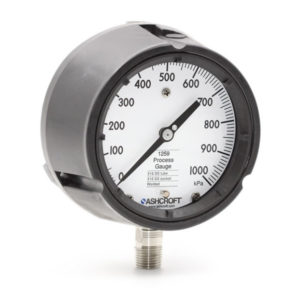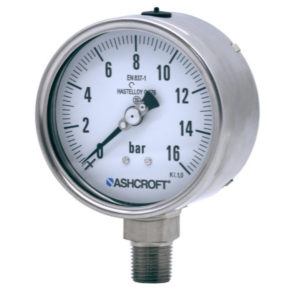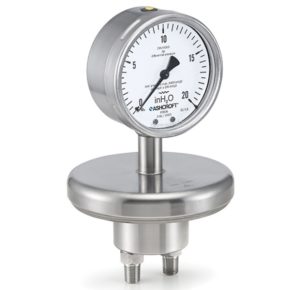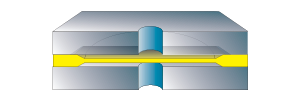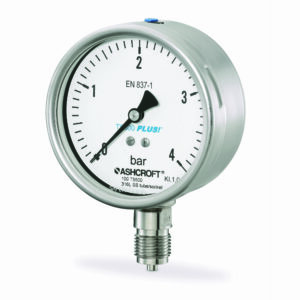

2462 Duragauge Pressure Gauge
2462 Duragauge Pressure Gauge
Data Sheets
- 📄 Data sheet process pressure gauge Duragauge 2462 🇬🇧
- 📄 Data sheet receiver pressure gauges 1377-1379-2462 🇬🇧
Installation + Maintenance
Declaration of Conformity
Selection Guides
Product + Technical Information
- 📄 TIP Measuring Pressure on Ammonia Applications 🇬🇧
- 📄 Product Information Page Welding an Instrument to a Diaphragm Seal ASH-PI-62B 🇬🇧
- 📄 Product Information Page Use of Steel Bourdon Tubes in Duragauges DU-PI-68 🇬🇧
- 📄 Product Information Page Stress Corrosion Cracking Resistance of K500 Monel vs Monel 400 in Hydrofluoric Acid DU-PI-73 🇬🇧
- 📄 Product Information Page Safety Concerns Using Repaired and Reconditioned Pressure Gauges ASH-PI-58A 🇬🇧
- 📄 Product Information Page Receiver Gauge and False Reading Gauge Dial ASH-PI-45 🇬🇧
- 📄 Product Information Page Product for Sour Oilfield NACE MRO0175 and Sour Petroleum Refining Operations NACE MRO0103 ASH-PI-60D 🇬🇧
- 📄 Product Information Page Magnetism of Nickel Copper Alloy DU-PI-64 🇬🇧
- 📄 Product Information Page High pressure Connection ASH-PI-61A 🇬🇧
- 📄 Product Information Page Gauges and Diaphragm Seals for Hydrogen Service DU-PI-46 🇬🇧
- 📄 Product Information Page Gauge Throttle Screw Selection ASH-PI-7A 🇬🇧
- 📄 Product Information Page Gauge Storage and Shelf Life ASH-PI-59 🇬🇧
- 📄 Product Information Page Gauge Safety ASH-PI-36 🇬🇧
- 📄 Product Information Page Gauge Low Temperature and Cryogenic Instrument ASH-PI-21D 🇬🇧
- 📄 Product Information Page Duragauge Safety Results on Solid Front Gauge DU-PI-32 🇬🇧
- 📄 Product Information Page Duragauge Movement Repair DU-PI-61C 🇬🇧
- 📄 Product Information Page Duragauge Dial Testing DU-PI-42 🇬🇧
- 📄 Product Information Page Duragauge Bourdon Tubing DU-PI-25A 🇬🇧
- 📄 Product Information Page Bourdon Rupture Proof Overpressure ASH-42D 🇬🇧
- 📄 Product Information Page Ammonia Applications ASH-PI-52 🇬🇧
- 📄 Product Information Page 316 Stainless Steel Bourdon Tube Hysterisis Error DU-PI-48B 🇬🇧
- 📄 Product Information Page 1/4″ High Pressure Tubing Connection DU-PI-24A 🇬🇧
- 📄 Custom dial artwork submital – ASH-PI-63 🇬🇧
Drawings + Models
Key Features
Easily adjustable micrometer pointer
PLUS!™ Performance (optional)
Teflon®-coated, 400 stainless steel adjustable Rotary movement
Wide selection of Bourdon tube materials, pressure connections and pressure ranges
Markets & Applications
Chemical and Petrochemical
Oil and Gas
Refinery
Offshore Oil and Gas
Natural Gas Transmission and LNG
Water and Wastewater
Waterjets and Waterblasters
- Specifications
- Downloads
Case or Body Material
Polypropylene
Process Connection Location
Lower
Lower back
Mounting
Flush
Stem
Surface
Process Connection Style
Threaded
Case Style
Solid front safety case with pressure relief back
Dial Size
6"
Accuracy
0.5% of span (ASME B40.100 Grade 2A)
Dampening
Throttle screw
PLUS!™ Performance
Pressure Type
Gauge pressure
Ranges
1 ... 2000 bar / 30000 psi
Vacuum
Compound
Wetted Parts Material
Bourdon tube bronze, socket brass
Stainless steel 316L (1.4404)
Monel
Ingress Protection
IP54
Data Sheets
- 📄 Data sheet process pressure gauge Duragauge 2462 🇬🇧
- 📄 Data sheet receiver pressure gauges 1377-1379-2462 🇬🇧
Installation + Maintenance
Declaration of Conformity
Selection Guides
Product + Technical Information
- 📄 TIP Measuring Pressure on Ammonia Applications 🇬🇧
- 📄 Product Information Page Welding an Instrument to a Diaphragm Seal ASH-PI-62B 🇬🇧
- 📄 Product Information Page Use of Steel Bourdon Tubes in Duragauges DU-PI-68 🇬🇧
- 📄 Product Information Page Stress Corrosion Cracking Resistance of K500 Monel vs Monel 400 in Hydrofluoric Acid DU-PI-73 🇬🇧
- 📄 Product Information Page Safety Concerns Using Repaired and Reconditioned Pressure Gauges ASH-PI-58A 🇬🇧
- 📄 Product Information Page Receiver Gauge and False Reading Gauge Dial ASH-PI-45 🇬🇧
- 📄 Product Information Page Product for Sour Oilfield NACE MRO0175 and Sour Petroleum Refining Operations NACE MRO0103 ASH-PI-60D 🇬🇧
- 📄 Product Information Page Magnetism of Nickel Copper Alloy DU-PI-64 🇬🇧
- 📄 Product Information Page High pressure Connection ASH-PI-61A 🇬🇧
- 📄 Product Information Page Gauges and Diaphragm Seals for Hydrogen Service DU-PI-46 🇬🇧
- 📄 Product Information Page Gauge Throttle Screw Selection ASH-PI-7A 🇬🇧
- 📄 Product Information Page Gauge Storage and Shelf Life ASH-PI-59 🇬🇧
- 📄 Product Information Page Gauge Safety ASH-PI-36 🇬🇧
- 📄 Product Information Page Gauge Low Temperature and Cryogenic Instrument ASH-PI-21D 🇬🇧
- 📄 Product Information Page Duragauge Safety Results on Solid Front Gauge DU-PI-32 🇬🇧
- 📄 Product Information Page Duragauge Movement Repair DU-PI-61C 🇬🇧
- 📄 Product Information Page Duragauge Dial Testing DU-PI-42 🇬🇧
- 📄 Product Information Page Duragauge Bourdon Tubing DU-PI-25A 🇬🇧
- 📄 Product Information Page Bourdon Rupture Proof Overpressure ASH-42D 🇬🇧
- 📄 Product Information Page Ammonia Applications ASH-PI-52 🇬🇧
- 📄 Product Information Page 316 Stainless Steel Bourdon Tube Hysterisis Error DU-PI-48B 🇬🇧
- 📄 Product Information Page 1/4" High Pressure Tubing Connection DU-PI-24A 🇬🇧
- 📄 Custom dial artwork submital - ASH-PI-63 🇬🇧
Drawings + Models
- Category: Process Gauges

